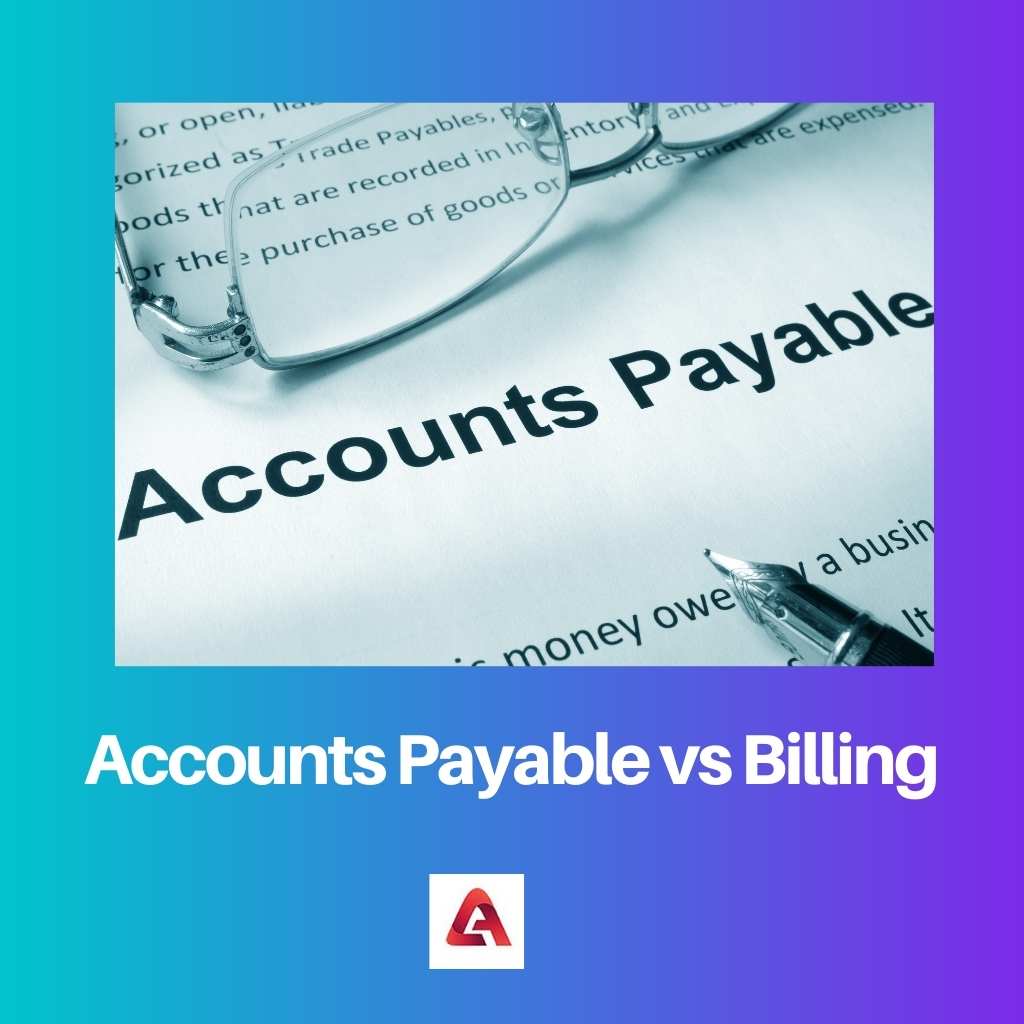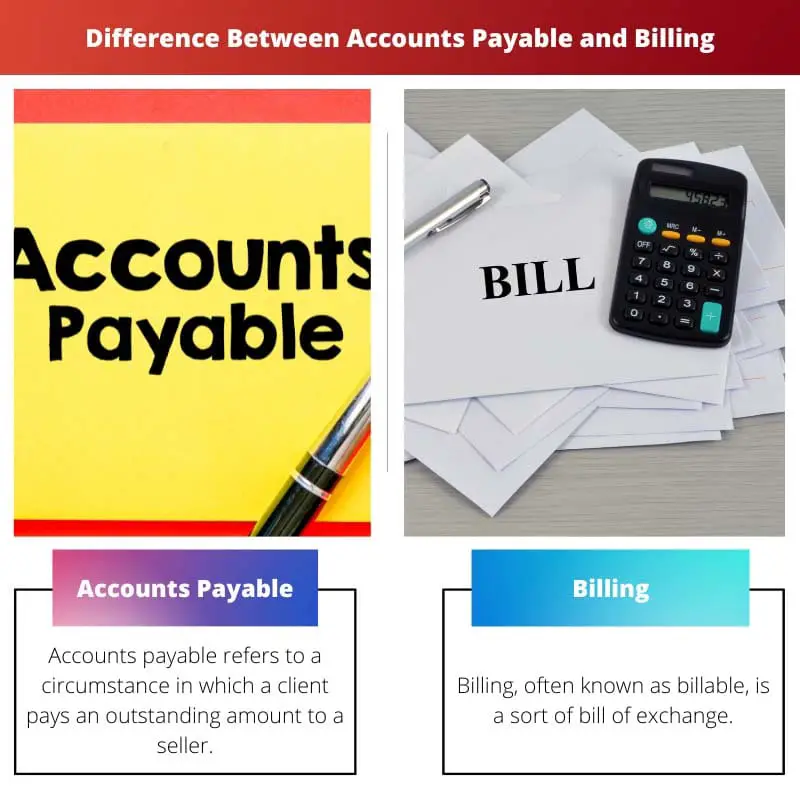Accounts payable refers to a circumstance in which a client submits payment for an outstanding amount owed to a supplier. It’s a current liability in the books of a customer.
A sort of bill of exchange is billing, known as a bill payable. The client or drawee is owed a specified amount of money by the holder, which is due on a specific maturity date.
Key Takeaways
- Accounts payable represents the amount a company owes to its suppliers for goods or services, while billing involves issuing invoices to customers for products or services rendered.
- Accounts payable is a liability on the company’s balance sheet, whereas billing generates accounts receivable, an asset.
- Accounts payable management involves tracking and paying outstanding invoices, while billing management focuses on creating, sending, and tracking customer invoices.
Accounts Payable vs Billing
The difference between Accounts Payable and Billing is that the payable bills do not always represent all of the accounts payable. All current account transactions are represented by Accounts payable, which is reflected in the user’s balance as current liabilities. However, on the contrary, all of the billing that is done results in a set of legally enforceable debt, which is represented by the accounts payable balance. Bills connected to financial statements are recorded in a distinct subsidiary book called the bills payable book.

Accounts payable refers to a circumstance in which a client pays an outstanding amount to a seller. It’s a current obligation in a customer’s book.
Accounts payable have no set maturity date. Because the account balance is an outstanding amount, the maturity can be determined based on the received credit period.
Users and customers make accounts due on invoice receipts for service receipt transactions and at the time of purchasing products.
Billing, known as billable, is a sort of bill of exchange. The drawee, or customer, owes the holder a particular amount of money that is due on a specific maturity date.
Billing has both pre-determined and fixed maturity dates. It’s also a physical document that’s being traded. Billing occurs when a customer or buyer accepts the dues to a seller on a specific date.
When this value is not paid, however, it rises. Billing is rigorously governed by the regulations that control negotiable instruments.
Comparison Table
| Parameters of Comparison | Accounts Payable | Billing |
|---|---|---|
| Represented by | Commensurate bills | Payable balance of accounts. |
| Situation | Indication of outstanding amount to a seller, by the customer as a payment. | The customer is indebted to the holder by a specific amount of money. |
| Maturity date | Not specific | Specific |
| Operated under | Jurisdictional laws cover general contracts. | Jurisdictional laws govern negotiable instruments. |
| Reported as | Current liabilities | Bills payable book |
What is Accounts Payable?
Accounts payable is rigorously governed by jurisdictional regulations that apply to all general transactions. All of the payable accounts are not always reflected by the bills that are due.
All transactions relating to the current account are represented by Accounts payable, which is reflected as current liabilities in the user’s balance.
Because the account balance is an outstanding amount, the maturity can be calculated using the received credit period.
Accounts payable is made by users and customers on invoice receipts for service receipt transactions and at the time of purchase of items.
Accounts payable refers to a circumstance in which a client indicates an outstanding amount to a seller as a payment. It is a current liability in a customer’s book. Accounts payable maturity dates aren’t always precise.
What is Billing?
The payable balance of accounts represents the legally enforceable debt that is created by all of the billing that is done.
The record of bills connected to financial statements disclosure is kept in a distinct subsidiary book called a bills payable book.
It’s also a physical document that’s being traded. Billing occurs when the dues to a seller are accepted by the customer or buyer on a specific date.
When this value is not paid, however, it increases. The jurisdictional regulations that govern negotiable instruments are scrupulously followed when it comes to billing.
Billing, known as a bill of exchange, is a sort of bill of exchange. The drawee, or client, is owed a specified amount of money by the holder, which is due on a specific maturity date.
Billing, on the other hand, has both pre-determined and fixed maturity dates.

Main Differences Accounts Payable and Billing
- Accounts payable is referred to as a situation of indication of outstanding amount to a seller by the customer as a payment. In the book of a customer, it is a current liability. On the other hand, billing or bill payable is a type of bill of exchange. Here the drawee or the customer is indebted to the holder by a specific amount of money which is due on a specific date of maturity.
- The maturity date of accounts payable is not strictly specific. The maturity can be calculated based on the received credit period as the account balance is an outstanding amount. On the other hand, in the case of Billing, it possesses both pre-determined and fixed dates of maturity. Also, it is a physical document that is exchanged.
- The accounts payable is made on an invoice receipt by the users and customers for service receipt transactions and at the time of purchase of goods. On the other hand, billing results when it is accepted by the consumer or buyer of the dues to a seller on a particular date. However, this value rises when not paid.
- Accounts payable is strictly operated under the jurisdiction of jurisdictional laws, which cover general contracts. On the other hand, Billing is strictly operated under the jurisdictional laws which govern negotiable instruments.
- All the accounts payable are not necessarily represented by the commensurate bills that are payable. On the other hand, all the Billing that is done forms a set of legally enforceable debt, which is represented by the payable balance of accounts.
- All the transactions related to the current account are represented via Accounts payable, and it is reported in the user’s balance as current liabilities. On the other hand, in the disclosure of the bills related to financial statements, the record is kept in a separate subsidiary book which is called a bills payable book.

- https://books.google.com/books?hl=en&lr=lang_en&id=xOSwV9uEyiEC&oi=fnd&pg=PP19&dq=Accounts+Payable+and+Billing&ots=wXIMJOinUM&sig=jLDdkluz9G6sU7bF1V_THgMdqSo
- https://ieeexplore.ieee.org/abstract/document/9166236/
